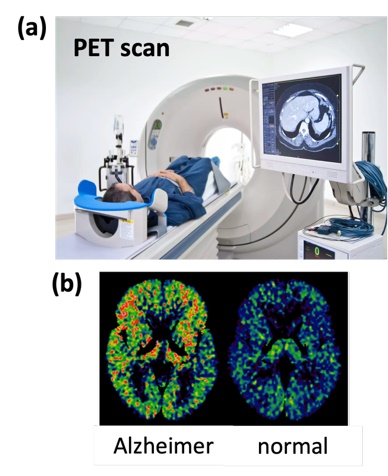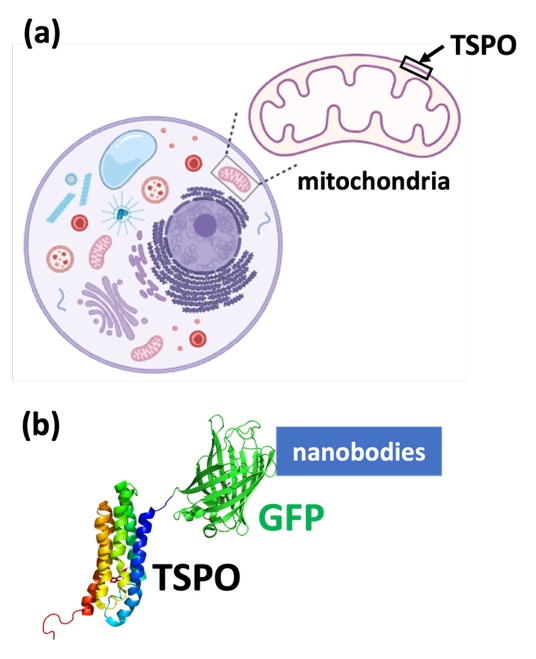Domain, Specialties : Biochemistry, Biophysics, Structural Biology
Keywords: membrane proteins, TSPO, expression systems, optical spectroscopy, X-ray and neutron scattering (SAXS/SANS)
Research Unit : LLB/MMB
Summary
Membrane proteins lie at the heart of cellular life and represent nearly 60% of current therapeutic targets. Yet, they remain poorly characterized: barely 3% of the structures in the Protein Data Bank (PDB) correspond to them. Their study is therefore a major scientific challenge, especially when it comes to producing them in a native and functional form.
We are interested in TSPO, a small and intriguing mitochondrial membrane protein present in the nervous system. Its exact role remains debated, but TSPO is already a central player in neuroimaging, notably used in PET scans as a marker of brain inflammation associated with traumatic brain injury, cancer, and neurodegenerative diseases (e.g., Alzheimer’s, Parkinson’s) (Fig. 1).

Fig. 1. TSPO as a therapeutic target in neuroimaging. (a) Positron Emission Tomography (PET); (b) overexpression of TSPO in the brain of an Alzheimer’s patient.

Fig. 2. Production and purification of TSPO.
(a) Localization of TSPO in the outer mitochondrial membrane; (b) purification strategy based on the recognition of the fluorescent fusion protein GFP by “nanobodies.”
A major challenge:
To obtain a clear vision of the structure/function relationship of TSPO in order to better understand its biological role and pave the way for new imaging and therapeutic tools.
Full description
👉 Objective 1: Produce TSPO in its native form
With the help of the ProtEx platform (I2BC, Saclay), we have already established proof of concept by expressing TSPO in native conditions in the yeast S. cerevisiae (Fig. 2). The internship will consist of optimizing this production and purification protocol, particularly in different environments (detergents, detergent/lipid mixtures, lipid nanodiscs)
👉 Objective 2: Explore its structure and function
The produced protein will be characterized using a range of biophysical and structural techniques:
- Optical spectroscopies (absorbance, fluorescence, circular dichroism),
- Light scattering (MALS, DLS/SLS),
- Small-angle X-ray and neutron scattering (SAXS at SOLEIL synchrotron, SANS at ILL Grenoble),
- Ligand-binding affinity measurements by microscale thermophoresis (MST).
The data obtained will allow comparison between the apo form and the ligand-bound form, to better understand binding and stability mechanisms.
References:
- Structure/function of mTSPO translocator in lipid :surfactant mixed micelles,
Saade C, Pozza A, Bonnete F, Finet S, Lutz-Bueno V, Tully MD, Varela PF, Lacapere JJ, Combet S. Enhanced, Biochimie 224, 3, 2024. - Effect of amphiphilic environment on the solution structure of mouse TSPO translocator protein,
Combet S, Bonneté F, Finet S, Pozza A, Saade C, Martel A, Koutsioubas A, Lacapère JJ. Biochimie 205, 61-72, 2023.
Location
The internship will take place at the Léon-Brillouin Laboratory (LLB, CEA, CNRS, Univ. Paris-Saclay), in collaboration with Dr. José Luis VAZQUEZ-IBAR at LPSM/I2BC, Univ. Paris-
Saclay, and Dr. Alexandre POZZA at LBPM/IBPC, Paris.
Internship conditions
- Internship duration: 4 to 6 months
- Level of study: Bac+5
- Training: Master 2
- Continuation in PhD thesis: Yes
- Application deadline: December 2026, 19th
Experimental skills
Master 2 student in biophysics, biochemistry, or physical chemistry, curious and motivated by structural biology and membrane proteins. A PhD continuation may be considered at the end of the internship.
Language: French or English.
Links
- Web site of the laboratory : LLB/MMB
- Personal web page of the supervisor: Sophie Combet
- Detailed flyer of the internship subject
Internship Supervisor
Sophie COMBET
Tél. : +33 1 69 08 67 20
E-mail :




